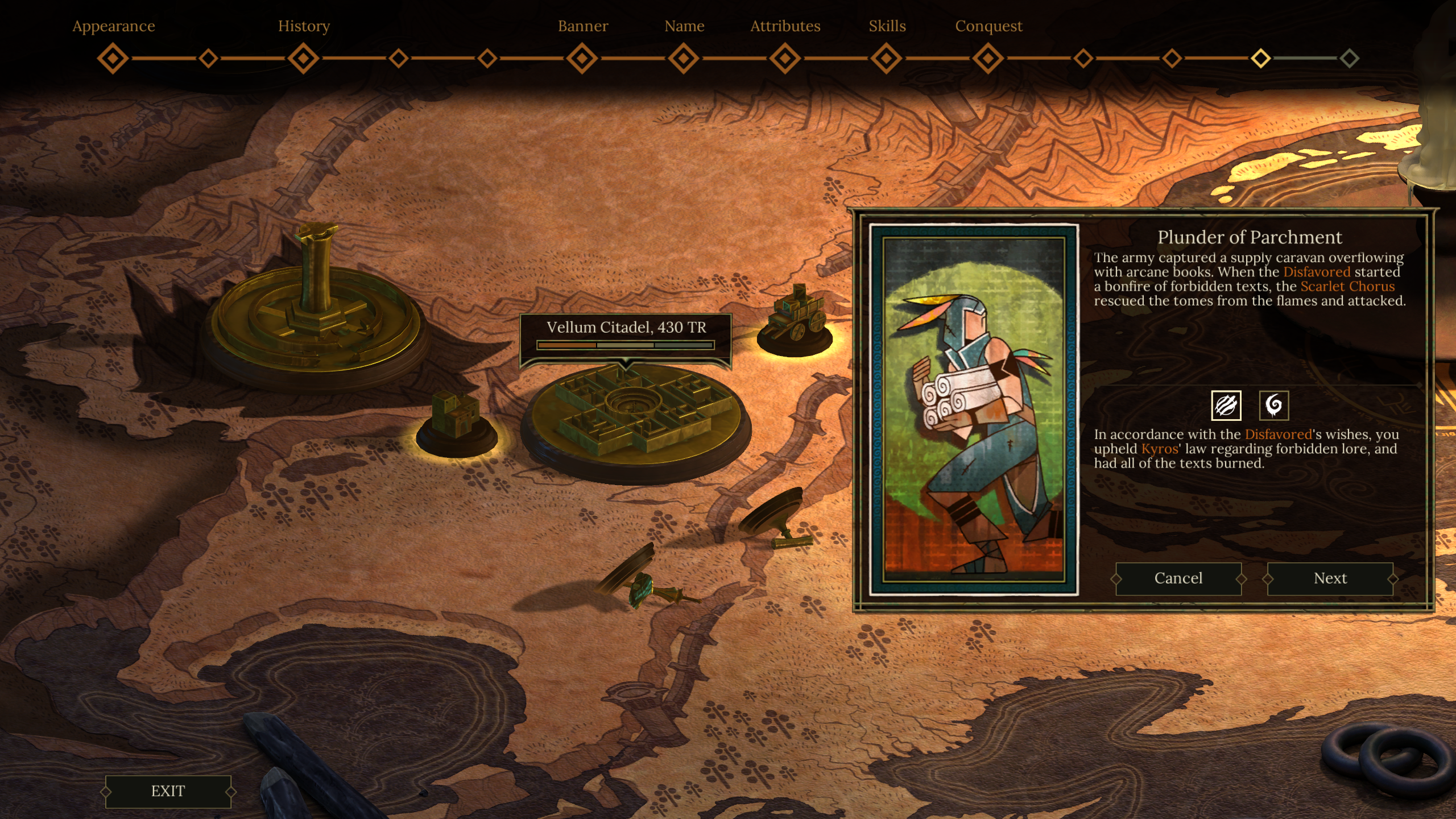Some of Tyranny's biggest decisions are in its first 10 minutes
The intro is like nothing we've seen in an RPG.

10 minutes into Tyranny, I melt an entire city of medieval nerds with lava. They die, smoldering along with their precious books and ink, after I summon a volcano where their library was. A school of magic is destroyed, and a treasure trove of arcane knowledge goes up in flames. My boss, the overlord, seems pleased.
Tyranny's intro is one of its more interesting divergences from Pillars of Eternity. Immediately after you create a character in Obsidian's be-the-bad-guy isometric RPG, you enter a prologue called Conquest. This isn't a cutscene, a tutorial, or a prelude mission. Conquest is played out on a world map, where you make a series of big decisions through text and concept art.
It's a clever setup for a few reasons. Over its three-year span, Conquest plants narrative seeds in locations and people you'll later see in the campaign. At one juncture, I had to pick a strategy to capture a fertile farm region that was locked in stalemate. The emperor sent me a powerful earth mage—I could use him to keep one of the continent's breadbaskets in tact as a vital food supply, or raze it and salt the earth. "The people of Azure will remember that decision," Tyranny game director Brian Heins tells me. "It will affect how they react to you if you venture to that part of the Tiers later in the game."
Conquest is also a smart way of managing Tyranny's scope. You get to feel the impact of big decisions that changed (or ended) the lives of thousands, but you don't have to wait 60 hours to see their effect. I felt invested in the story in minutes because I was making these big swings in the world. If anything, Tyranny seems like it could be on the shorter side, as old-school RPGs go: you have eight days to fulfill an edict given to you by the overlord, and this quest hangs over your head from the very outset of the game. "Failing to resolve the terms of the Edict within the eight-day timeframe would end the game. Kyros doesn't play around when it comes to her Edicts," says Heins.
I felt invested in the story in minutes.
Most of your Conquest choices are about which faction of your army you want to favor in a particular situation. The Disfavored are your hardened veterans, the spartans who have perhaps become too proud for their own good. Contrasting them is the Scarlet Chorus, a ragtag horde of sneakier, deadly fighters that prefer to recruit from those they conquer rather than killing them.

It's clear that the bickering between these two military siblings will be one of Tyranny's central themes, and Conquest does a good job of demonstrating the personality of these factions with your choices rather than with passive exposition. After I conquered a location called Lethian's Crossing, I had to pick which faction would leave a portion of its forces behind to occupy it. When I chose the Scarlet, Tyranny told me of the consequence: "The Scarlet Chorus flooded Lethian's Crossing with overeager and undisciplined recruits. In the first few days of occupation, settlers suffered under rampant theft, murder, rape, and arson," the description read. This wasn't a 'bad' choice, Obsidian reassured me, just another one with consequences I'd see later on. The Conquest text hinted that as a result, the Scarlet Chorus controlled the shipments of iron and weapons exported from that city, and that shipments were often light or absent.
'Choice' remains a big buzzword in RPGs and games as a whole, but Tyranny's approach, even outside its be-the-bad-guy premise, is original and effective. There is a risk that front-loading so many big choices—nuking whole cities with magic, and whatnot—might dampen the impact of others later. But after a few hours with Tyranny I'm happy to see it has some big, structural changes in store for me: this isn't simply Pillars of Eternity played from the perspective of Sauron.
Keep up to date with the most important stories and the best deals, as picked by the PC Gamer team.

Evan's a hardcore FPS enthusiast who joined PC Gamer in 2008. After an era spent publishing reviews, news, and cover features, he now oversees editorial operations for PC Gamer worldwide, including setting policy, training, and editing stories written by the wider team. His most-played FPSes are CS:GO, Team Fortress 2, Team Fortress Classic, Rainbow Six Siege, and Arma 2. His first multiplayer FPS was Quake 2, played on serial LAN in his uncle's basement, the ideal conditions for instilling a lifelong fondness for fragging. Evan also leads production of the PC Gaming Show, the annual E3 showcase event dedicated to PC gaming.

